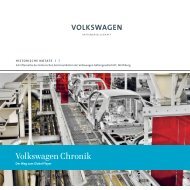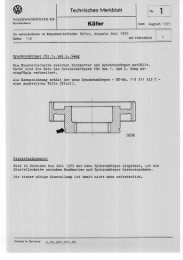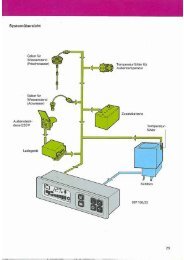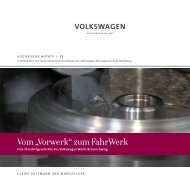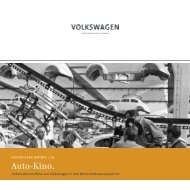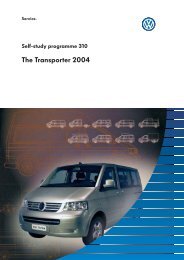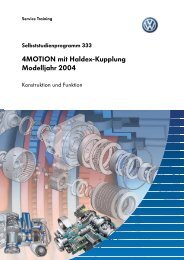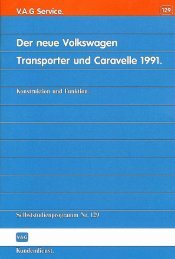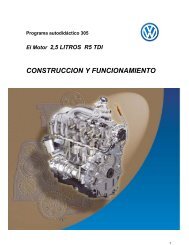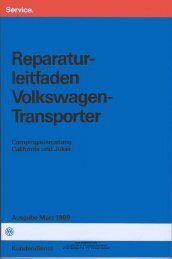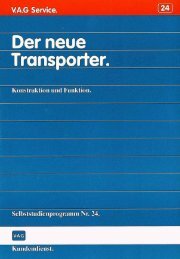HN 2: The British and their Works
HN 2: The British and their Works
HN 2: The British and their Works
You also want an ePaper? Increase the reach of your titles
YUMPU automatically turns print PDFs into web optimized ePapers that Google loves.
compared to other manufacturers. Major Hirst had visited the<br />
exhibition, accompanied by Colonel Radclyffe, to ascertain a<br />
suitable price for the export saloon. <strong>The</strong> market analysis indicated<br />
that the Volkswagen was comparable with the Skoda, which<br />
now became the benchmark for determination of prices. 190<br />
In fact there could hardly have been a worse moment to start up<br />
the export business with Volkswagens. In August 1947 the<br />
material supply crisis was at its height, for which reason, on the<br />
advice of Kemmler <strong>and</strong> Steinmeier, production was throttled<br />
back to 800 vehicles <strong>and</strong> the comm<strong>and</strong>ed programme of 1,000<br />
vehicles per month was postponed by six months. Once again, at<br />
the beginning of September 1947, the <strong>British</strong> had to correct the<br />
already revised instruction to increase monthly production to<br />
2,500 vehicles by July 1948. In agreement with the representatives<br />
of the Joint Export Import Agency <strong>and</strong> the VAW planning<br />
department, it was now firmly resolved to affect the production<br />
increase during the coming year. Prior to this the occupation<br />
requirements were to be reduced to 300 vehicles per month,<br />
leaving the rest available for export <strong>and</strong> for the German market.<br />
General manager Münch suggested reducing the ordered programme<br />
slightly <strong>and</strong> making up the deficit at a later date, so as<br />
to be able to export some vehicles immediately. Major Hirst<br />
rejected this on the grounds that firm resolutions had already<br />
been adopted in this matter. In December 1947, in respect of<br />
raw material allocations for the export <strong>and</strong> civilian business,<br />
there was a yawning gap of 3,350 tonnes of steel. One reason<br />
for this was the provision that steel quotas for vehicles intended<br />
for export were to be supplied by preference where a firm<br />
contract existed. In the case of planned deliveries, however, the<br />
^<br />
Economic Administrative Office only released small quantities.<br />
Colonel Charles Radclyffe immediately set about procuring the<br />
necessary quantities of steel from them. 191<br />
<strong>The</strong> number of vehicles exported in 1947, given in the statistics<br />
as 1,963, is misleading, because as of June the vehicles delivered<br />
to the civilians connected with the Military Government were<br />
accounted via the export procedure. Of the 126 cars "exported"<br />
in June, 116 went to <strong>British</strong> families <strong>and</strong> 10 to the foreign press. 192<br />
<strong>The</strong> expectations which above all the <strong>British</strong> had placed in the<br />
export business since the middle of the year were not fulfilled.<br />
In numerical terms the export of Volkswagens in 1947 was negligible.<br />
However, the figures were unimportant when set against<br />
the fact that export had been finally pushed through in the face<br />
of the ministerial resistance which had been encountered, <strong>and</strong><br />
was at last able to get going properly in 1948. It may even be that<br />
this delay was a good thing in the long run. <strong>The</strong> factory management<br />
had sufficient time to transform the st<strong>and</strong>ard version into<br />
a model fit for export. In order for the Volkswagen to survive<br />
among the foreign competition, a series of cosmetic measures<br />
was implemented. <strong>The</strong> export cars were far better crafted <strong>and</strong><br />
equipped, from the paintwork <strong>and</strong> an appealing selection of<br />
finishes, to the upholstery, <strong>and</strong> the chromium-plated bumpers<br />
<strong>and</strong> hubcaps. With this constant insistence on improving the<br />
quality of the vehicles destined for export, Major Hirst made a<br />
decisive contribution to establishing Volkswagen’s good reputation.<br />
■<br />
76 77<br />
THE EXPORT QUESTION



